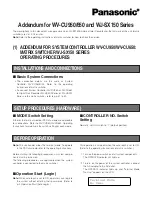
st
eut
e T
echnol
ogies GmbH & Co. K
G
Brück
ens
tr
aße 91, 32584 Löhne, Germany
, www
.s
teut
e.c
om
//
RF I/O SW868/SW915/SW917/SW922-4E-2,2Ah
3 / 24
Montage- und Anschlussanleitung / Funkschalter
Mounting and wiring instructions / Wireless switch
Instructions de montage et de câblage / Interrupteur de radio
Istruzioni di montaggio e collegamento / Interruttore di radio
Instruções de montagem e instalação / Interruptor de rádio frequência
Инструкция по монтажу и подключению / Радио-выключатель
English
The device of type SW917 is intended for use in Brazil. It complies with
the requirements of Resolucão 242/2000.
The device of type SW922 is intended for use in Japan. It complies with
the requirements of ARIB STD-T108.
The device consists of three parts: the energy supply with lithium bat-
tery, the wireless part with integrated 4-times interface for the exter-
nal sensors and the connection part for the external sensors. The er-
nergy supply is carried out by a not rechargeable 3.6 V lithium-thionyl-
chloride battery and a nominal capacity of 2.2 Ah. The sensor/switch
part is evident at the four 4-pole M12 plug-in connectors. At this plug-
in connector, the inductive sensors RF IS M12/M18 or M30 or other
mechanical switches with gold-plated contacts can be connected.
Therefore, the connecting cable, Material No. 1189960, can be used. It
is available as accessory. The sensors/switches have an effect on the
wireless part equally and independently. Each detected switching pro-
cess generates a wireless transmission. With the mechanical switch-
es, one NO/NC contact is required from plus (pin 1) to the entry (pin 4).
The battery status is transmitted with every transmission. The trans-
mission is carried out at a frequency of 868.3 MHz (EU) or 915.0 MHz
(USA, Canada, Mexico) or 917.0 MHz (Brazil) or 916.5 MHz (Japan). It is
possible to transmit a status signal that transmits the current switch-
ing state of the entries independent from a switching signal. The time
is set to 10,000 sec. as standard. The receiver must conform to the
sWave® protocol of the steute module.
Status signal
It is possible to set of the interval of the status signal. Therefore the
enclosure must be opened and the jumper can be set to adjust the in-
terval of the status signal. Please observe that a shorter interval re-
duces the battery life.The monitoring of the interval is possible using
a special receiver.
Jumper
Interval
without jumper
no status signal
Position 1
10 s
Position 2
100 s
Position 3
1000 s
Position 4
10 000 s
Mounting and wiring
Mount the wireless switch on an even surface. The wireless switch
must be installed according to the mounting and wiring instruc-
tions of the receiver. The wireless range accordingly depends on the
local conditions. Thus, the radio signal can be strongly affected by
conductive materials. This also includes thin foils, e.g. aluminium
laminations on insulation materials. A test with the field strength
indicator swView 868, Material No. 1190393, or swView 915, Material
No. 1221794, should be carried out (swView 922 and swView 917 on
request only).
Design of wireless range
Because radio signals are electromagnetic waves, the signal is attenu-
ated on its way from the transmitter to the receiver. This means the
electrical as well as the magnetic field strengths decrease inversely
proportionally to the squared distance of transmitter and receiver
(E,H~1/r²). In addition to this natural restriction of the wireless range,
further interference factors occur: Metal parts, e.g. armours in walls,
metal foils of thermal insulations or vapour-deposited metal layer
heat protection glass reflect electromagnetic waves. Therefore, a so-
called deadspot can be found behind them. Radio waves are able to
penetrate walls, but the attenuation increases even more than in the
free field.
Penetration of radio waves:
wood, gypsum, glas uncoated
90...100%
brick stone, press boards
65...95%
armoured concrete
10...90%
metal, aluminium lamination, water
0...10%
Typical wireless ranges are:
Line of sight in free field:
approx. 450 m
Line of sight indoors:
approx. 40 m
Line of sight in free field (SW922):
approx. 150 m
Line of sight indoors (SW922):
approx. 20 m
Mounting notes
Mounting notes for inductive non-flush inductive proximity sensors
series RF.
Notices
The processing of one switching command from transmitter to re-
ceiver lasts approx. 80 to 100 ms on basis of the sWave® data trans-
mission. The switching signal of a transmitter must not be generated
in shorter time sequences otherwise this signal will be suppressed.
Subject to technical modifications. Reconstruction and alterations at
the device are not allowed. Moreover, steute does not assume any li-
ability for recommendations made or implied by this description. From
this description new claims for guarantee, warranty or liability cannot
be derived beyond the general terms and conditions of delivery.
Maintenance
With rough conditions, we recommend routine maintenance as follows:
1. Remove all dirt or particles.
2. Clean only with a damp cloth.
3. Replace battery: The batteries max be replaced by the operator. To
replace the battery loosen the cover screws with a wrench and re-
move the cover. Insert the battery according to the positive terminal
marking. Afterwards mount the cover and tighten it hand-screwed
with the cover screws.
Safety notes
The electrical connection may only be carried out by authorised per-
sonnel.
The radio receiver must not be used in connection with devices
that may directly or indirectly serve health- or life-saving purposes or
cause hazards by operation to human beings, animals or asset values.




































